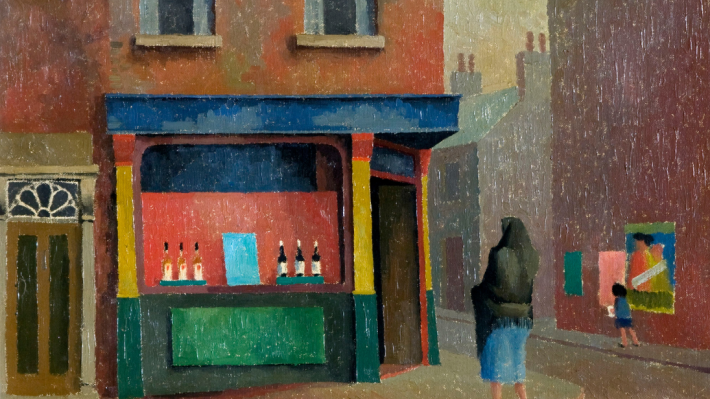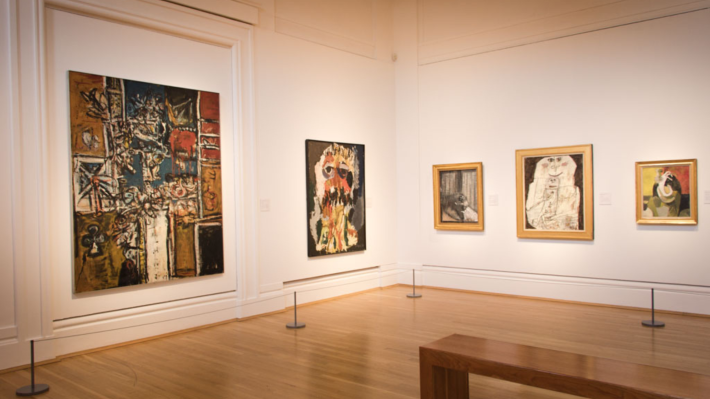
Loss, war and the city
Learn about Colin Middleton and his creative response to the war. Guest story by Dr Dickon Hall.
Colin Middleton was already well-established as an artist in Belfast by September 1939, when Britain entered World War Two. He was the first artist in Ireland to work consistently in a manner influenced by Surrealism, and this is evident in the unsettling mood of his first creative responses to the war, such as the 1938 painting Souvenir: Hastings, which explores the darkness of events in continental Europe and the possible threat of invasion.

Early years of the war
Middleton worked on several series of works simultaneously during the early years of the war, when he was living with his widowed mother near the Antrim Road and continuing to work as a linen designer. One of these series demonstrates the technical skills Middleton had learned from this work, in a small group of cityscapes painted with precision of line and a smooth, highly finished surface. They show arrangements of simplified buildings, reduced to some of the essential elements of urban life, a church, a factory, an off-licence or a fish and chip shop.
The image of the factory is more central to another work related to this series, Strange Openings. Its dark windows are perhaps a reference to the black-out blinds of the war (black felt was also hung across the windows of a linen mill after its windows were blown out in the Blitz of 1941), but the gaping doors of the factory seem as if they are about to devour the terrace of houses beside it. Middleton’s political sympathies lay with the workers, rather than the mill and factory owners whom he described as the ‘Linen Kings’, and this painting seems to express his attitude towards industrialisation.

The most significant group of paintings completed during these early years of wartime, between 1940 and 1942, also demonstrate Middleton’s sense of kinship with the people of Belfast. Middleton never owned a car, so that he spent his days cycling or walking around the city and knew it intimately. He painted a series of Belfast cityscapes in a manner close to neo-Impressionism, precisely applying short strokes of paint to primed canvas, depicting specific areas of the city and often concentrating on the Lagan as it ran through the city.
Belfast Blitz
The Blitz of Belfast began at Easter, 1941, and in the paintings of this period Middleton seems to become closer to the city of his birth, and its people. In works such as If I were a blackbird his empathy with others is clear, and the loneliness many experienced in wartime, as well as the trauma of those who had endured the bombing, gives these works a gentle but unmistakeable emotion.
Middleton usually depicts quiet corners of the city and his paintings convey the sense of the artist as an anonymous observer, so it is interesting to note that he never painted directly from his subjects; he often made quick drawings on the spot in a sketchbook, but always painted in his studio, and these works take on a quality that is universal as well as specific to Belfast. By painting a mother pushing a pram beside the Lagan, or people working in their allotments, he celebrates the continuity of ordinary life despite the great strain of the bombing and the war, in a way that would have been understood across many countries at that time.

Alongside the subtle resilience of these paintings, however, Middleton was also working on a series of striking and unsettling surrealist and symbolist works, many of which he exhibited in 1943 at the Belfast Museum and Art Gallery (now the Ulster Museum) in the first exhibition they held upon re-opening after the Blitz. If the Belfast cityscapes might seem like an assertion of the city’s survival in their record of daily life, these surrealist images reveal the unavoidable concerns and fears of wartime.
Personal life
Middleton had been widowed in 1939, after only four years of marriage, so these paintings reflect his personal grief, as well as engaging with the broader issues of war. Their imagery is unsettling, from the headstones of Magdalene to the collapsing buildings and unsupported ladders of The Yellow Door, but there are surprising visual connections with Belfast. For example, the church building in Magdalene is highly simplified but does recall St Peter’s on the Antrim Road, where Middleton had married Maye in 1935. The terraced housing and factory chimneys of Old Landscape might represent elements of the city taken out of context.

This 1943 exhibition, which included 115 paintings, charted Middleton’s response to loss, war and the bombing of Belfast, and gradually marks his recovery and a renewed sense of optimism. In 1942 he met Kathleen, who was to become his second wife and in 1944, as the end of war came into sight, they moved into a house on the coast at Ballyhalbert, along with Kathleen’s two young children. By the summer of 1945 they had returned to Belfast and in October, only weeks after the end of the war, Middleton painted The Holy Lands, an image full of energy and optimism in which newspapers are left to blow away with their headlines unread, and daily life takes over once again.

Artworks ©️ The Estate of Colin Middleton
You might like
Colin Middleton: ‘Among this Peace and Noise’ opens at Ulster Museum
Showing until 14th January 2024, the exhibition examines the artist’s relationship with Belfast and his development through paintings and drawings spanning six decades.
Colin Middleton: Among this Peace and Noise
An exhibition featuring paintings and drawings spanning six decades by artist, Colin Middleton.
Shock of the New
A look at the early years of modern art as part of our collections, from the 1920s to 1970s.


